Have you ever wondered which insects could outrun you? Believe it or not, the insect world is full of speedsters that are built for rapid movement. From darting dragonflies to zippy cockroaches, some insects can move surprisingly fast, given their small size.
Not only are these quick critters fascinating to learn about, but understanding their speed can also offer insights into their survival tactics and roles in nature. So, buckle up as we zoom through our list of the fastest insects on the planet. You might be surprised at who makes the cut!
Fastest Flying Insects in the World
1. Horsefly – Up to 90 mph

The horsefly is the fastest insect in the world, clocking in at speeds of up to 90 miles per hour!
©iStock.com/dabjola
Many believe that dragonflies hold the title of the fastest insect. Surprisingly, it’s the horsefly that takes the lead.
The horsefly, often seen pestering horses and other animals, probably gets its name from this behavior. These insects can be quite big, some reaching around two-thirds of an inch long. Their appearance is marked by a dark hue, striped upper bodies, and dark underbellies. Their large, multifaceted eyes are also a distinguishing feature.
While the male horseflies have a preference for plant nectar and pollen, the females are more aggressive, seeking blood. Their target includes anything that moves and has a dark shade. Their persistence is notable as they won’t give up biting their chosen target until they get their blood meal or meet their end.
Many horseflies and their cousins, the deer flies, thrive in places with thick vegetation, especially if it’s close to water sources. This is because these habitats offer the moist soil essential for their young ones to grow. So, it’s common to find them around freshwater wetlands, coastal marshes, and clearings within woods.
When it comes to speed, horseflies are champions. Especially the male Hybomitra hinei wrighti, who’s been clocked at a jaw-dropping rate of 90 mph when chasing after a potential mate! Yes, you heard that right – 90 miles per hour!
2. Skippers – Up to 37 mph

Flying at speeds of up to 37 miles per hour, skippers are the second fastest insect in the world.
©Kyle Reynolds/iStock via Getty Images
Skippers are fascinating insects found across the globe, with around 3,500 species in existence. They’re renowned for their swift, agile flight patterns.
Interestingly, skippers seem to bridge the gap between butterflies and moths. They fly during the day and pollinate like butterflies but sport short, hairy bodies similar to moths.
Young skippers, or caterpillars, munch on the foliage of various plants like grasses, reeds, and trees. Each species usually sticks to a specific group of plants for their diet. When they mature, they predominantly sip nectar, though occasionally, they might “drink” from mud to gain essential minerals.
You’ll often find these creatures in moist meadows and forested areas where sunlight filters through gaps in the trees. While the adult skippers remain active only when the sun is up, the younger ones might nibble on leaves in dim light conditions. One unique trait of skippers is their tendency to stay put; they’re not known for long migrations and usually stick around their birthplace for life.
Flying at speeds up to 37 mph, they have reflexes that are among the quickest in the insect kingdom. To put that in perspective, they could potentially keep up with a galloping horse!
3. Ladybug – Up to 37 mph

The ladybug comes in tied with the skipper, with its ability to fly up to 37 miles per hour!
©Ger Bosma Photos/Shutterstock.com
You might be surprised to learn that the ladybug is one of the fastest insects in the world! These small, round insects, also known as ladybirds in some parts of the world, are typically around a quarter of an inch in length. They’re easily recognizable by their vibrant red or orange coloration adorned with black spots. While the classic image of a ladybug features red with black spots, there are numerous species with variations in color and spot patterns — with more than 5,000 species around the world.
One of the unique aspects of ladybugs is their ability to fold and tuck their delicate wings neatly away when they’re not in use. This helps protect their wings from damage.
Ladybugs are voracious predators, feeding on aphids and other small insects that can harm plants. This natural pest control makes them a gardener’s ally, giving them the apt nickname “gardener’s best friend.”
When threatened or searching for food, ladybugs can surprisingly reach a top speed of 37 miles per hour! Their wings can flap up to 85 times per second. Interestingly, ladybugs have the ability to fly for up to 2 hours without taking a break, which is no mean feat!
4. Dragonfly – Up to 35 mph

Often mistaken to be the fastest insect in the world, the dragonfly comes in at number four.
©LifeCollectionPhotography/Shutterstock.com
Dragonflies, sometimes referred to as devil’s arrows, darners, or devil’s darning needles, belong to a vast group of around 3,000 aerial hunter insect species.
Distinguishing features of dragonflies include their elongated bodies and two sets of delicately veined wings. These wings, often clear, might carry subtle, colorful patterns. A unique trait that sets them apart from damselflies is the different shapes of their front and rear wings. Typically, a dragonfly’s wingspan ranges between two and five inches.
These insects are natural predators. They feast on small insects like mosquitoes, flies, bees, and even butterflies, capturing them mid-flight. Dragonflies are opportunistic and eat what’s readily accessible.
You’ll commonly spot them near freshwater sources — think riversides, canals, or lakes. Interestingly, they’ve been around for a while, with fossils indicating they’ve graced our planet for over 300 million years! They were among one of the first winged insects to evolve, and some fossil dragonflies have been found to have wingspans of up to two feet!
It’s also worth noting that many dragonflies are territorial, especially the males. Some guard their area against their own kind, while others fend off different dragonfly species or even entirely different insect groups.
Dragonflies surpass many other insects in flight distance and altitude. Racing at a whopping 35 mph, these insects can cover a distance of 100 times their body length in a second when flying forward and manage three body lengths while moving backward.
5. Hawk Moth – Up to 33.7 mph

The hawk moth is a large and fast insect that can have a wingspan of up to 8 inches long!
©aabeele/Shutterstock.com
Among the world’s most impressive moths, the hawk moth stands out. Known for their speed and agility in flight, these moths are a spectacle in the insect world.
In terms of size, hawk moths are on the larger side. Their physique is built for powerful flying, with a distinct head and big eyes. The front wings of these moths are elongated and overshadow their smaller rear wings. When they’re not flying, their wings fold above their body in a triangular shape. Their wingspan can vary, generally falling between 2 and 8 inches.
One interesting feature of the hawk moth is its proboscis. This straw-like structure remains curled up unless it’s time to feed. When a hawk moth comes across a flower, it floats in the air, uncurls its incredibly long proboscis, and sips the nectar, much like using a straw.
You can find these moths in diverse environments, from coastal areas to nearly barren mountaintops. They’re adaptable, but they do have their preferences. The right conditions are essential for their survival, and even slight shifts in their typical surroundings can disrupt their habitat.
Hawk moths have a knack for locating fragrant flowers even in the dark, making them efficient nocturnal pollinators.
These insects are one of the fastest moving. At times, their rapid movements can make them seem like hummingbirds. In fact, they can dart around at speeds up to 30 mph and have the unique ability to hover in place, darting forwards and backward just like a hummingbird does.
6. Asian Giant Hornet – Up to 25 mph

The largest hornet in the world, the Asian giant hornet can reach speeds of up to 25 miles per hour.
©iStock.com/Bruno Uehara
The Asian giant hornet, native to certain regions of Asia, is one of the fastest hornets!
Recognizable by its striking yellowish-orange head contrasted with a dark body and alternating bands of yellow and black on its tail section, this hornet is hard to miss. Asian giant hornets build their homes underground, and a typical nest might house roughly 100 workers.
Holding the title of the world’s biggest hornet, this insect can grow up to 2 inches long with an impressive 3-inch wingspan. Their diet mainly consists of honey bees and other small insects, but they won’t say no to some ripe, soft fruit.
These hornets have a liking for forested areas and the foothills, steering clear of flatlands and high-altitude regions. They are ingenious nest builders, either digging out their own homes, taking over tunnels left behind by rodents, or setting up shop near decaying pine roots.
When it comes to temperament, the Asian giant hornet is both brave and super aggressive. Their favorite target? Honey bees. They have a preference for honey bee larvae, which they feed to their offspring. In their pursuit of this delicacy, they can wipe out entire bee colonies.
Speed-wise, these hornets are quite the athletes. They can cover ground up to 60 miles per day when hunting and can reach speeds of 25 mph. A word to the wise: if you ever cross paths with one, don’t try to outrun it. Chances are, it’ll catch up!
Fastest Running Insects in the World
7. Australian Tiger Beetle – Up to 5.6 mph

The
tiger
beetle holds the title of the fastest land or running insect in the world.
©wagtail/Shutterstock.com
Meet the speed demon of the insect world: the Australian tiger beetle!
This little critter, often no bigger than an inch, boasts a segmented body, lean legs, sharp jaws, and large eyes that give it keen eyesight.
Both as adults and larvae, tiger beetles are predators. They have a diverse diet, feasting on beetles, flies, caterpillars, ants, grasshoppers, spiders, and many other tiny creatures. While adult tiger beetles actively chase down their prey, the younger ones lay in wait, ambushing any insect that strays too close.
Interestingly, they have a global presence. A few places, like Hawaii, Antarctica, the Maldives, and Tasmania, are exceptions. You’ll find them in abundance in Australia, especially in the drier regions.
While many beetles prefer the cover of night, some tiger beetles are daytime adventurers, especially those armed with chemical defenses. It’s also intriguing how some species synchronize their life cycles, leading to an influx of adults appearing all at once, making them easier to spot for a short period.
The Australian tiger beetle holds the record for being the fastest land insect, clocking in at 5.5 mph. Sure, it might not sound like much, but considering its size, it’s racing at an astonishing 171 times its body length every second!
8. Flea – Up to 4.25 mph

When they jump, fleas can reach speeds of up to 4.25 miles per hour!
© ThamKC/Shutterstock.com
The flea is a minuscule, blood-sucking insect renowned for its impressive jumping skills.
These little pests range from a deep red to a brownish-black shade. Their sturdy outer shell features hairs pointing backward, aiding them in navigating through a host’s hair and ensuring they cling on securely. Despite being only around 1/8 inch in size, they’re notoriously tricky to catch, mainly due to their swift movements.
On a daily basis, a female flea drinks blood equivalent to 15 times her weight. While the mature fleas feast on blood, be it from a cat, dog, or other mammals, the younger ones, which are blind, get their nutrients from the organic matter in their surroundings.
Fleas love environments that are damp, shaded, and humid. Spaces under decks or porches can become their winter homes. Other favored spots include tall grassy areas, piles of leaves, stacked wood, areas with pebbles, and sandy patches.
Fleas might not have wings, but they make up for it with their extraordinary jumping skills. They can leap up to 7 inches vertically and cover a horizontal distance of nearly 13 inches. Their remarkable jump is powered by an energy burst from their thorax, pushing through their leg sections and finally onto their feet. This rapid energy release launches fleas into the air, allowing them to achieve speeds close to 4.25 mph!
9. American Cockroach – Up to 3.4 mph

It may not be surprising to hear that the American cockroach is one of the fastest land insects in the world.
©skifbook/Shutterstock.com
The American cockroach is the largest among common cockroaches and is often viewed as a pest.
Adults of this species sport a reddish-brown color, accented by a lighter brown or yellowish outline near the front part of their body, known as the pronotum. Interestingly, male cockroaches appear slightly longer than females since their wings point out a bit more beyond their body’s end. At the rear of both genders, there’s a pair of thin, jointed extensions.
Adults have an average length of 1.6 inches.
Being omnivorous, these cockroaches have a diverse palette. They don’t shy away from feeding on cosmetics, sipping on milk, nibbling on fresh plant shoots, or even tasting soap and fermented fruits.
In the great outdoors, they prefer damp, shaded spots like the insides of hollow trees, stacks of wood, or mulch. Sometimes, they might also be spotted hiding beneath roof tiles or in attic spaces. While they primarily reside outside, they venture indoors when lured by food, water, or to escape harsh weather.
The American cockroach can sprint at speeds of 3.4 mph, which is equal to a remarkable 50 times its body length every second. To put that into perspective, it’s like a person racing at a blazing 210 mph!
10. Water Striders – Up to 2.23 mph

When darting across the water, water striders can reach speeds of around 100 times their body length in just one second.
©Stephan Morris/Shutterstock.com
Water striders are fascinating insects that appear to defy gravity by “walking” on water, thanks to the principle of surface tension.
Measuring around half an inch in length, these insects have slender bodies and three pairs of legs. What enables them to stroll on water are their legs, which are equipped with minuscule hairs. These hairs ward off the water while trapping air, allowing the striders to float effortlessly.
The front legs, which are shorter than the others, play a crucial role in grabbing and securing their prey. Their diet mainly consists of surface insects and larvae, including mosquitoes and the occasional unlucky dragonfly that ends up on the water.
You can spot water striders across the U.S., gracefully skimming the surfaces of tranquil or gently flowing waters. They have a particular fondness for still ponds, seasonal water pools, and marshes.
Apart from their mesmerizing water-walking act, water striders are beneficial critters. Thankfully, these striders pose no harm to humans and don’t have a biting habit.
They can dart across the water at a rate of 2.23 mph or about 100 times their body length in a single second. For a 6-foot human to achieve a similar feat in water, they’d have to clock in at a mind-boggling 400 mph!
11. Saharan Silver Ant – Up to 1.9 mph

In the heat of the Saharan desert, these Saharan silver ants can reach speeds of 1.9 miles per hour.
©Pavel Krasensky/Shutterstock.com
The Saharan silver ant calls the scorching Sahara Desert its home and holds the title as the fastest among the globe’s 12,000 ant species!
These ants are adorned with a unique layer of hair that covers the tops and sides of their bodies. This specialized hair has a triangular shape, making it exceptionally reflective to both visible and near-infrared light, crucial for deflecting the sun’s intense rays.
Their survival in one of the world’s most hostile environments, given their small size of roughly three-eighths of an inch in length, has always intrigued scientists.
These ants primarily eat carrion, feasting on creatures that succumb to the desert’s unforgiving heat. These resilient ants venture out in the Saharan sun when the ground heats up to a sizzling 70°C (158°F). Remarkably, they manage to keep their internal temperatures below a crucial threshold of 53.6°C (128.48°F).
Their ability to thrive in the harsh Sahara landscape is thanks to a combination of unique behaviors, physical characteristics, and physiological adjustments.
In a recent study conducted in the sunlit dunes of Douz, Tunisia, these swift ants recorded speeds of around 2.8 feet per second, which translates to 1.9 miles per hour. This impressive pace is like covering 108 times their body length every second. Imagine humans moving at a comparable rate; we’d be racing at speeds exceeding 400 mph!
Summary of the Fastest Insects in the World
| Rank | Insect | Type of Insect | Top Speed |
|---|---|---|---|
| 1. | Horsefly | Flying | 90 mph |
| 2. | Skippers | Flying | 37 mph |
| 3. | Ladybug | Flying | 37 mph |
| 4. | Dragonfly | Flying | 35 mph |
| 5. | Hawk Moth | Flying | 33.7 mph |
| 6. | Asian Giant Hornet | Flying | 25 mph |
| 7. | Australian Tiger Beetle | Running | 5.5 mph |
| 8. | Flea | Running | 4.25 mph |
| 9. | American Cockroach | Running | 3.4 mph |
| 10. | Water Striders | Running | 2.23 mph |
| 11. | Saharan Silver Ant | Running | 1.9 mph |
The photo featured at the top of this post is © Pavel Krasensky/Shutterstock.com
Thank you for reading! Have some feedback for us? Contact the AZ Animals editorial team.






